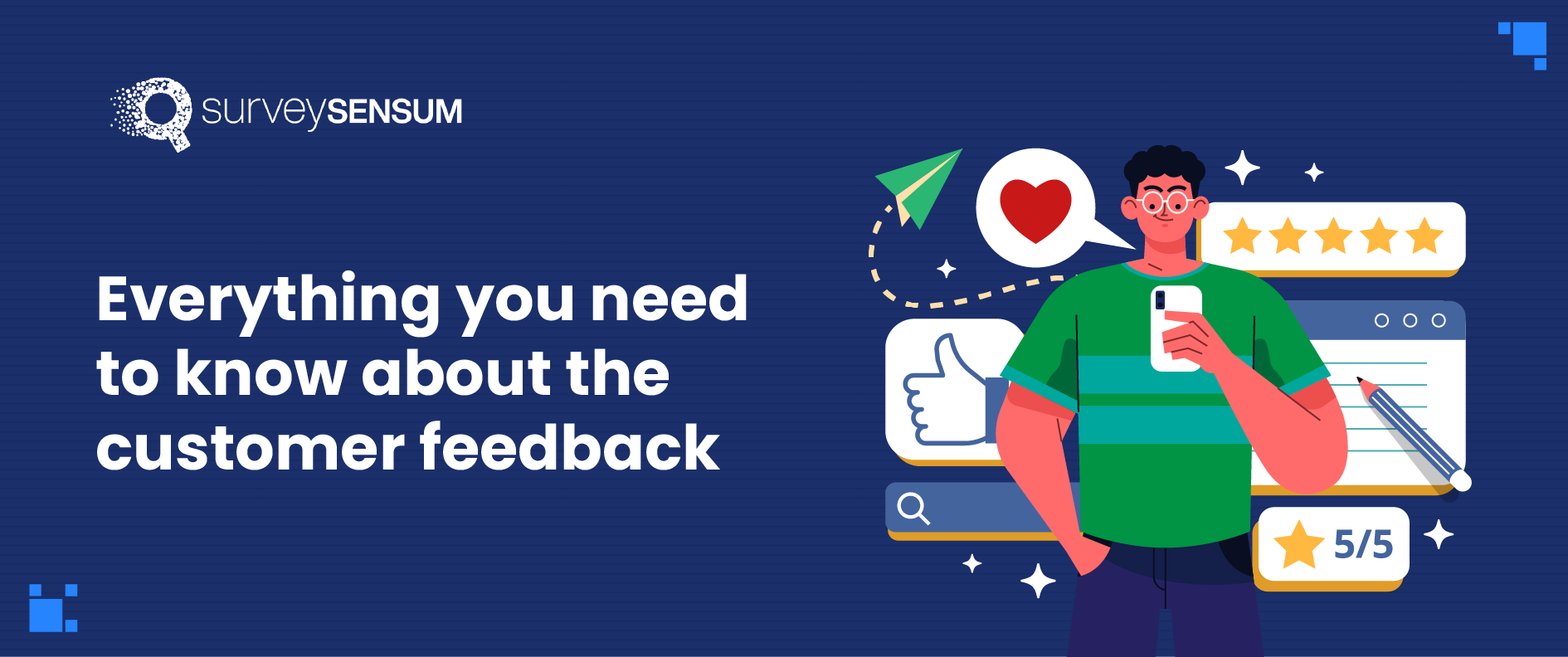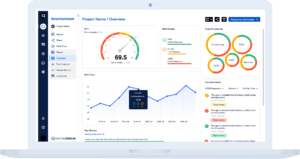
Customer Feedback is important! We all know this. But why? Why is every business focusing and recommending to focus on it? What is it about customer feedback that is helping them improve their services or product? And even if one like to start working on it, what is the first place to start?
Let’s discuss these in this comprehensive article, ‘Everything you need to know about customer feedback.’
So, what is customer feedback?
Customer feedback is anything that your customer shares with you after interacting with your business or using your product or service.
Customer feedback can be shared in the form of reviews, ratings, and comments on multiple platforms in multiple ways. And it takes several forms. It is not entirely text-driven nor does it come only in the form of multimedia. It is a cluster of all of them, which when combined gives an idea of customer satisfaction and brand loyalty.
But, why is customer feedback important?
From just-launched startups to enterprises that have a continent-spanning presence, every business must gather and analyze customer feedback. Why?
Let’s take an example here. Jenny recently opened a bakery with a bang! People came from all over the town but the footfall decreased after a month or two. Why? How’d she has known it?
Answer – Customer Feedback
Customer feedback helps you understand what you are doing right and what you are doing wrong. It is only by listening to the voice of your customers you’ll know if they are satisfied or not, what is it that they are looking for, what can be improved, and what needs to be maximized!
Now that we know the why, let’s discuss the effective ways to gather customer feedback.
10 most practical methods to collect customer feedback
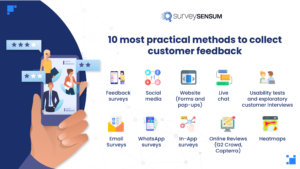
1. Feedback surveys
Customer feedback surveys are basically a set of 4-5 questions sent to the customer after their interaction with the brand asking about their experience of it. The surveys can be sent on multiple platforms such as WhatsApp, email, in-app, etc.
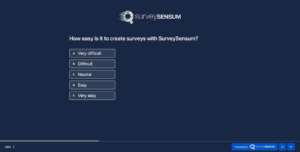
2. Social media
Social media polls and social media listening can help give a clear picture of what customers are feeling and talking about a business. Also, social media channels like Facebook and Twitter have built-in poll tools that help you gather customer feedback. In fact, with advanced tools like text analytics software, it is even possible to figure out whether the feedback that is shared by thousands is positive, negative, or neutral in tone.
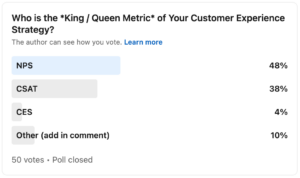
3. Website surveys (Forms and pop-ups)
The feedback of the customers or visitors who just visited your website can be gathered via website forms. As soon as they take or are about to take a defined action such as exiting the page, ending the article, filled the contact form, a popup can be shared with them asking for their experience with the website.
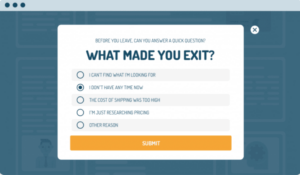
4. Live chat
Thanks to the live chat software and chatbots, it is not easy to integrate customer feedback questions at appropriate junctures of the customer journey or on specific pages of the website itself. These help drive contextual customer feedback collection.
5. Usability tests and exploratory customer interviews
Usability testing is another great way to gather customer feedback. Simply ask them to test your product and observe their flow. This will help you identify what can be improved and what not. Also, go for customer interviews. The simplest way to gather customer feedback is to get on a call with them and schedule an interview.
6. Email surveys
When direct one-to-one interaction with customers is required, emails prove to be a handy medium. After their interaction with you, simply send them an email to understand their experience with your brand. It is one of the most common ways to gather customer feedback as it enables customers to share their feedback in their own time and space.
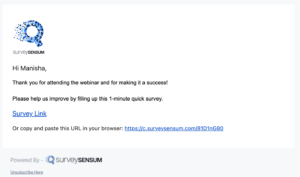
7. WhatsApp surveys
Most survey approaches act like a one-sided conversation — where one person asks and the other person answers. They may not provide the best customer experience. It is here that WhatsApp surveys can make a difference. Since the survey questions are styled more like a conversation, it boosts the response rate. And also, who is not on WhatsApp anymore?
→ How to create WhatsApp surveys in less than 5 minutes?
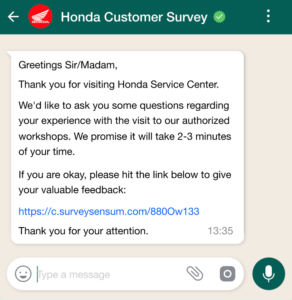
8. In-App surveys
In-app surveys make it possible to collect feedback without forcing customers to leave the app.
They also help collect feedback for specific app features and understand the customer intent with context. They act as on-screen triggers in which users can interact with touch gestures.
9. Online reviews (G2 Crowd, Capterra)
Online reviews are the best form of customer feedback. They are the most honest and reliable kind of feedback as the customer only shares their feedback after properly using your product or services. You can gather this feedback from multiple sources such as G2 Crowd, Capterra, Google reviews, and multiple review websites.
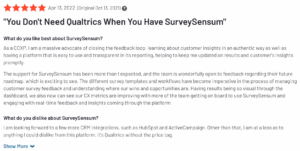
10. Heatmap analysis
Heatmaps are analytical tools that populate the graphical presentation of user actions on a website or mobile app. They work by tracking the mouse pointer movements, clicks, or touch actions on the interface. Tracking heatmaps help understand whether customers are interacting with a product or service in an intended manner.
Now that we know where to gather customer feedback, let’s talk about the type of customer feedback you can gather from these sources.
Gather Customer Feedback With SurveySensum!
Types of Customer Feedback
Customers talk about many things such as onboarding, customer service, subscription upgradation, pricing, features, technical difficulties, and more. There are multiple types of customer feedback. It’s time to categorize it.
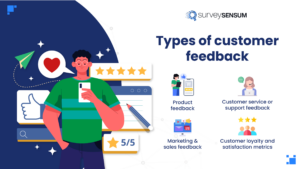
1. Product feedback
Anything related to the product that your customer has shared with you comes under product feedback. It could be about technical glitches, feature requests, updates, customization, etc.
2. Customer service or support feedback
Customer service wins the customers. Every time you help them over support calls, live chats, feedback emails, or knowledge articles, gather their feedback on the experience they had with you. That comes under customer support feedback.
3. Marketing & sales feedback
Before buying your product or service, your customer interacts with your sales rep and marketing campaigns. Gathering marketing and sales feedback helps you improve just that! It tells you how efficient your sales process is and how effectively your marketing campaigns are working.
4. Customer loyalty and satisfaction metrics
Customer loyalty metrics tell you how loyal your customers are to your brand, on the other hand, the satisfaction metrics help you gauge their satisfaction level. And these metrics are analyzed by the feedback gathered via NPS and CSAT surveys.
When to ask for customer feedback?
Knowing when to ask for customer feedback is incredibly important. Because customers hate untimely surveys.
So, when should you ask for feedback?
First, map the customer journey. Know how your customers found you, and what path they followed to buy your product. Then, ask the questions post every interaction they have with your brand.
Now the question is – What questions should you ask at each touchpoint? Well, this would help you! 🙂
Taking customer feedback is not enough. You need to use it as well.
Closing the feedback loop
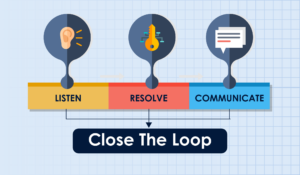
What does closing the feedback loop actually means?
Closing the feedback loop simply means, listening to the customer’s problems, understanding their issues, and resolving them.
When your customers share their feedback with you over a chat, support call, or survey, listening to them is not enough! You need to reach out to those people to understand the issue in detail so that you can take apt action on it and remove it from the call.
So, here is the 5 step process to close the feedback loop.
- Collate all the feedback (quantitive and qualitative) from all the channels.
- Run an analysis on them and identify the most common issues with the negative sentiment.
- Call only 5-10 customers who actually put in their efforts to describe their bad experience. Understand their problems in detail.
- Share these experiences with your team. Generate ideas, prioritize, and create an action plan.
- At last, inform your customers that you’ve listened to them and the necessary action has been taken.
This simple yet IMPACTFUL process is called closing the feedback loop.
And there is so much more to it!
Now that you are doing all of it, what are the actual benefits of spending time, energy, and other resources on collecting customer feedback? Here are a few!
Launch Your First NPS,CSAT, or CES Survey!
What are the benefits of customer feedback?
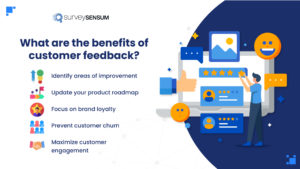
1. Identify areas of improvement
The biggest benefit of collecting customer feedback is that it helps identify lapses in your product or service. Ultimately, customers are the best judges of what works and what doesn’t. Asking them for suggestions to improve customer feedback can make a business improve its offerings by notches.
Airbnb is one brand that does this the best with its emails to customers who have checked out properties.
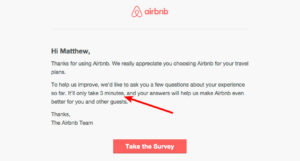
2. Update your product roadmap
Also, when the product surveys tell you what features or customization your customers are liking or not. They also tell you what is it they are looking for and if they want any feature to be included in the product. This helps you understand the product expectations and update your roadmap accordingly.
3. Focus on brand loyalty
Customer feedback and brand loyalty share a directly proportional relationship. Brands that act on customer feedback make customers feel more special and valued.
When it comes to listening to customers, Casper, the mattress company seems to have won a gold medal at it.
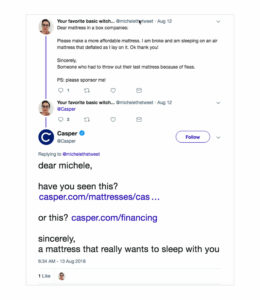
4. Prevent customer churn
Customer feedback can help you identify what is working and what is not! For example, adding exit surveys can help you understand why your customer is downgrading, leaving, or what is it that they didn’t find. Knowing this can help a great deal in preventing customer churn and boosting retention rates!
5. Maximize customer engagement
There could be instances when the customer might be disappointed when the product is not available or the service is not up to the mark. In such cases, customer feedback can definitely act as a lever that can cement customer relationships for the future. Gathering feedback from such customers can help you know what is wrong and work on it!
Here is how Zappos responded to a disappointed customer and turned it into a possible transaction for the future.
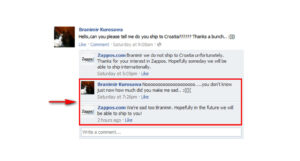
Final takeaway
Steve Jobs once said, “Get closer than ever to your customers. So close that you tell them what they need well before they realize it themselves.”
Customer feedback is the first step to getting closer to your customers. It gives an idea of what went right and what went wrong when the customer interacted with the brand.
In today’s world, customer feedback comes from a variety of sources. From dynamic social media to the ever-prominent email, customer feedback can take any form. There are several tools and methods that help collect customer feedback in the right fashion. Closing the feedback loop is the starting point for that.
If used correctly, customer feedback can help boost your customer engagement, brand identity, and ultimately revenues as well. The benefits are too good to ignore.
So, how are you planning to use customer feedback as a strategic tool for business growth?







